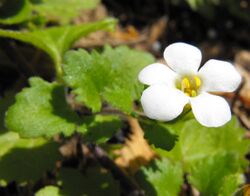Biology:Chaenostoma cordatum
| Chaenostoma cordatum | |
|---|---|

| |
| Chaenostoma cordatum 'Snowflake' | |
| Scientific classification | |
| Kingdom: | Plantae |
| Clade: | Tracheophytes |
| Clade: | Angiosperms |
| Clade: | Eudicots |
| Clade: | Asterids |
| Order: | Lamiales |
| Family: | Scrophulariaceae |
| Genus: | Chaenostoma |
| Species: | C. cordatum
|
| Binomial name | |
| Chaenostoma cordatum (Thunb.) Benth.
| |
| Synonyms | |
| |
Chaenostoma cordatum, also known as Sutera cordata, Bacopa cordata, Sutera diffusus, pikmin flower, or Bacopa (not the genus Bacopa), is one of 52 species in the genus Chaenostoma (Scrophulariaceae), and is native to South Africa .[1]
Taxonomy
Chaenostoma cordatum was first named in 1835 by Sir William Jackson Hooker.[2] The synonym Sutera cordata originated from Otto Kuntze in 1891.[3]
Distribution and habitat
Chaenostoma cordatum lives predominately on the southern coast of South Africa ,[4] where it had originated.[1]
Cultivation
Chaenostoma cordatum is a short-lived evergreen perennial for zones 9-11. It grows annually in colder climates, but requires full sun to flower profusely.[5] Cultivars include 'Bridal Showers', 'Snowflake', 'Giant Snowflake', and 'Pink Domino'.
The Pikmin Flower
A new cultivar of Bacopa, trademarked Bacopa 'Cabana®' in a collaboration between Nintendo of America and Syngenta Seed's Flower Brand, was the subject of a marketing campaign for the 2001 video game Pikmin. The name "Pikmin Flower" was coined in this campaign, due to the resemblance of the flowers that bloom from the heads of fully matured Pikmin species in the video games. While some claims reported Bacopa 'Cabana®' as an entirely new species or subspecies created by Nintendo, the plant is actually a selectively bred cultivar of the existing species, emphasizing specific traits for ornamental purposes. Peter Main, then executive vice president of sales and marketing for Nintendo of America, said that the flower "demonstrates that at the core of Nintendo is creativity". In April 2002, seeds of the flower were released to the public.[6][7]
See also
References
- ↑ 1.0 1.1 "Gardening: Snowstorm bacopa is a low-maintenance plant" (in en-US). 2016-06-27. https://www.redlandsdailyfacts.com/lifestyle/20160627/gardening-snowstorm-bacopa-is-a-low-maintenance-plant.
- ↑ Hooker, William Jackson (1835) (in en-gb). Companion to the Botanical magazine :being a journal, containing such interesting botanical information as does not come within the prescribed limits of the magazine; with occasional figures. 1 (1st ed.). pp. 377. https://www.biodiversitylibrary.org/page/34221098#page/376/mode/1up.
- ↑ Kuntze, Otto (1981). Revisio generum plantarum:vascularium omnium atque cellularium multarum secundum leges nomenclaturae internationales cum enumeratione plantarum exoticarum in itinere mundi collectarum .... 2 (2nd ed.). pp. 467. https://www.biodiversitylibrary.org/page/3889#page/93/mode/1up.
- ↑ "African Plant Database: Sutera cordata (Thunb.) Kuntze". https://africanplantdatabase.ch/en/nomen/93864.
- ↑ Loughrey, Janet. "Bacopa Plant - How to Grow Sutera Cordata - Garden Design". https://www.gardendesign.com/annuals/bacopa.html.
- ↑ Ahmed, Shahed (2006-05-17). "Pikmin becomes a flower" (in en-US). https://www.gamespot.com/articles/pikmin-becomes-a-flower/1100-2831784/.
- ↑ IGN Staff (2001-12-12). "Meet the Pikmin Flower" (in en). https://www.ign.com/articles/2001/12/12/meet-the-pikmin-flower.
External links
Wikidata ☰ Q7649928 entry
 |



